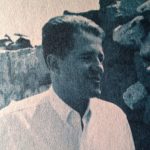Peru’s First Peace Corps Staff (Part Two)
 Peru was tantamount to a second home for William Mangin who happened to have been born and raised in Syracuse, N.Y. After one year at Syracuse University, he joined the Navy V-12 program, was sent to St. Lawrence University in Canton, N.Y., then to Cornell Midshipman’s School where he was commissioned an Ensign. Assigned to amphibious forces, he was sent to the Pacific and participated in the Marshall Islands invasions.
Peru was tantamount to a second home for William Mangin who happened to have been born and raised in Syracuse, N.Y. After one year at Syracuse University, he joined the Navy V-12 program, was sent to St. Lawrence University in Canton, N.Y., then to Cornell Midshipman’s School where he was commissioned an Ensign. Assigned to amphibious forces, he was sent to the Pacific and participated in the Marshall Islands invasions.
Discharged in 1946, he returned to Syracuse for a degree in anthropology and mathematics, then went on to Yale for an M.A. in anthropology. In 1951, he went to Peru with a grant from the Social Science Research Council to study drinking practices among Quechua speakers in the high Andes.
His report, eventually published, showed that a society could contain heavy drinking patterns (corn beer, super cane rum) and yet very little alcoholism. The next year, he operated the Vicos Project as field director. This involved renting a large hacienda, Vicos, 2000 Quechua speakers were brought in as subjects for educational and health programs and assigned to carry out new agricultural methods.
Another year at Yale earned Mangin his Ph.D. and he then joined the anthropology Syracuse. At the same time, he taught courses in anthropology at the New York State Medical School also in Syracuse.
In 1957, he returned to Peru with a grant from the National Institute of Mental Health to spend two years studying the mental health problems of migrants from the mountains to the slum barriadas surround Lima.
“At that time,” he says, “I lived the way the Peace Corps wants its Representatives to live now—mainly because I didn’t have any money.”
This investigation resulted in another report. Back to Syracuse University for the academic years 1959-60, Mangin returned to Peru the next summer, to Vicos again, where he went to work with psychoanalysts who were interviewing the Vicos farmers.
In the summer of 1961, he returned again, this time to Lima to study how decisions are made in the Peruvian government and then compare the process with another study on decision-making in the United States government. Back to the U.S., Mangin happened to be in Philadelphia when he got a telephone call from Richard Ottinger, Peace Corps operators officer for South America’s west coast. The call led to his coming to Washington for an interview with Mankiewicz, to his joining the Peace Corps in June, 1962, and to his return to Lima on July 3. The next day, July 4, Dawrin Bell joined him.
As Bell subsequently described his arrival, “There was the Lima Peace Corps office—it happens to be in the Lincoln Building on Washington Street. And I show up for work on July 4. How patriotic can you get?”
Research Document: Who’s Who in the Peace Corps Overseas Administration (1963)
The photographs are by Rowland Scherman, Paul Conklin and Jim Walls, first photographers for the agency.
Need more on Vicos Project, which blew up in Frank’s face but I remember in training he called the Vicos blow up a victory….
WM Evensen
1964-66 Peru
WM Evensen,
The book, “Cultural Frontiers of the Peace Corps” is also available on Amazon. There is an excellent review by RPCV Hugh Pickens, who served in Peru, posted there, also.
WM Evenson,
There is an excellent study of Vicos in “Cultural Frontiers of the Peace Corps” edited by Dr. Robert B. Textor, former PC staf in 1961. The book was published by M.I.T, in 1966. At one time, it was available online by Stanford University. It currently is not. We are trying to get it online, again. You might try getting it through Interlibrary loan.